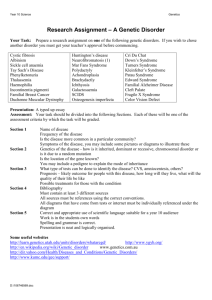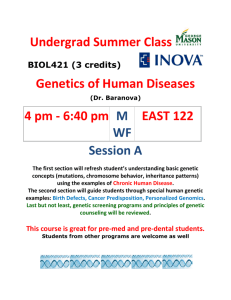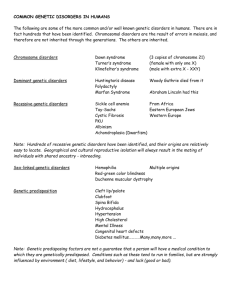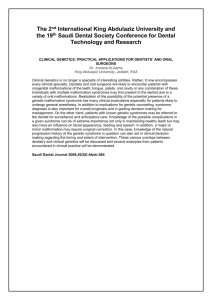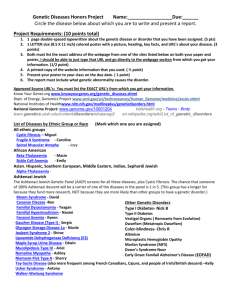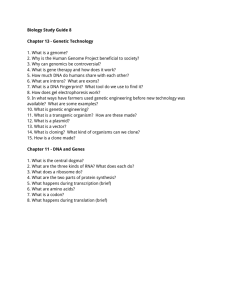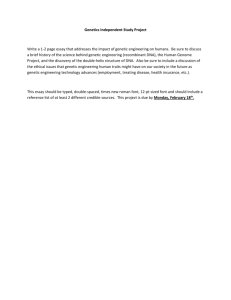File
advertisement
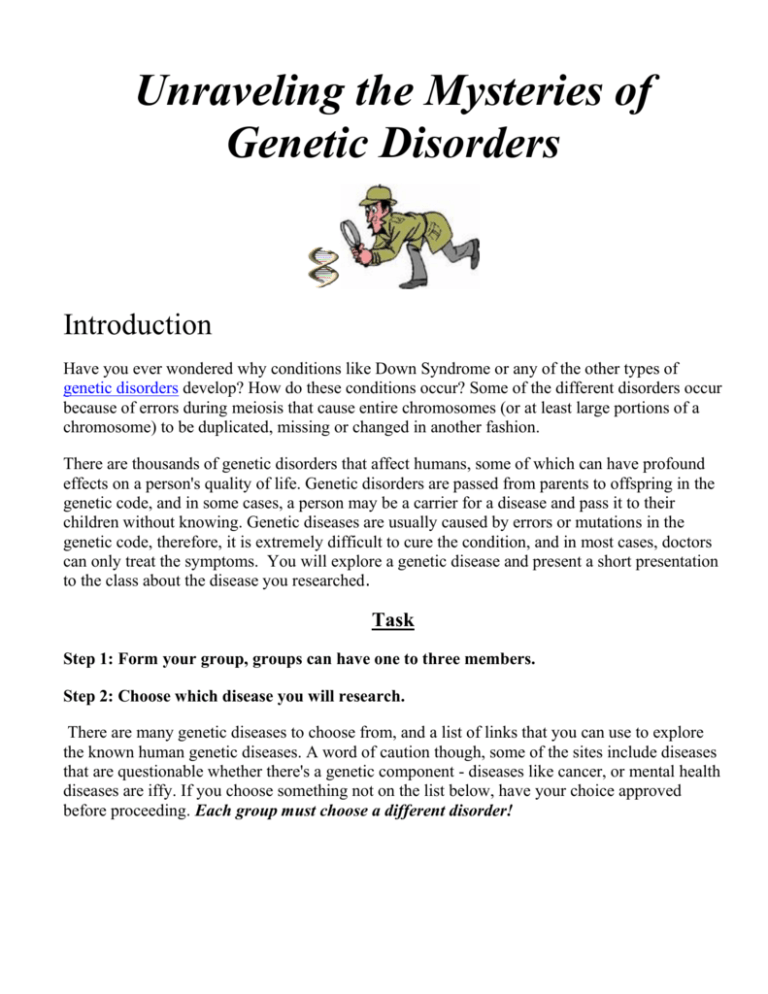
Unraveling the Mysteries of Genetic Disorders Introduction Have you ever wondered why conditions like Down Syndrome or any of the other types of genetic disorders develop? How do these conditions occur? Some of the different disorders occur because of errors during meiosis that cause entire chromosomes (or at least large portions of a chromosome) to be duplicated, missing or changed in another fashion. There are thousands of genetic disorders that affect humans, some of which can have profound effects on a person's quality of life. Genetic disorders are passed from parents to offspring in the genetic code, and in some cases, a person may be a carrier for a disease and pass it to their children without knowing. Genetic diseases are usually caused by errors or mutations in the genetic code, therefore, it is extremely difficult to cure the condition, and in most cases, doctors can only treat the symptoms. You will explore a genetic disease and present a short presentation to the class about the disease you researched. Task Step 1: Form your group, groups can have one to three members. Step 2: Choose which disease you will research. There are many genetic diseases to choose from, and a list of links that you can use to explore the known human genetic diseases. A word of caution though, some of the sites include diseases that are questionable whether there's a genetic component - diseases like cancer, or mental health diseases are iffy. If you choose something not on the list below, have your choice approved before proceeding. Each group must choose a different disorder! List of possible Genetic Disorders to Present: Achondroplasia (Dwarfism) Albinism Adrenal hyperplasia Autism/ Asperger syndrome Cystic Fibrosis Down Syndrome (Trisomy 21) Duchenne Muscular Dystrophy Familial Dysautonomia Gardner syndrome (intestinal polyposis) Gaucher’s Disease Hemophilia Huntington’s Disease Jacobsen Syndrome Klinefelters Syndrome Klippel-Feil Syndrome Genetic and Rare Conditions Site http://www.kumc.edu/gec/support/ Leukodystrophy Lou Gehrig’s Disease (ALS) Marfan Syndrome Moebius Syndrome Muscular Dystrophy Parkinson’s Polycystic Kidney Disease Progeria Proteus Syndrome Retinoblastoma Rett’s Syndrome Sickle Cell Tay-Sachs Disease Tourette Syndrome Turner Syndrome http://yourgenesyourhealth.org Genetic Disorder Library http://learn.genetics.utah.edu/units/disorders/whataregd To learn more about different genetic disorders, browse through the Genetic Disorder Library. Genetics Education Center http://www.kumc.edu/gec/ . Seeks to help educate people about genetics. The National Human Genome Research Institute http://www.nhgri.nih.gov /. Explains about the human genome project. Department of Energy - Human Genome Project Information http://www.ornl.gov/hgmis /. Provides a lot of information about the human genome project. A Gene Map of the Human Genomehttp://www.ncbi.nlm.nih.gov/science96/. You can see the mapping of several different chromosomes found within the body. Learning about the Human Genome Project and Genetics through the World Wide Web http://www.kumc.edu/gec/hgpwww.html . Looks at the ethical issues of genetic research. What is Genetic Testing? http://www.lbl.gov/Education/ELSI/Frames/genetic-testing-f.html . the basics of genetic testing; talks about ethical issues that happen due to genetic testing http://www.genome.gov/10001204 http://ghr.nlm.nih.gov http://kidshealth.org/teen/your_body/health_basics/genes_genetic_disorders.html Step 3: Research your disorder Your presentation to the class will need to provide an overview of the disease, addressing what causes it, what the effects and symptoms are, and how likely it is to pass the disease on to the next generation. Use the following questions to guide you in your research: Medical 1. How does a person inherit it? Is it dominant or recessive? 2. What are the possible genotypes of the parents? If the disease is a chromosomal abnormality, describe the abnormality. 3. How prevalent is the disease in the population (include statistics)? 4. What are the chances of a person with this disease passing the disease to their offspring (include possible scenarios)? 5. How is the disease diagnosed? 6. What are the physical symptoms of the disease? 7. What is the life expectancy of someone with the disease? 8. How can the disease be treated? Personal 1. What is everyday life like? What is the quality of life? 2. What limitations does the person have? 3. What are some organizations that can help a family with a child's disorder (web links) 4. How possible is it that a cure will be found? Step 4: Prepare Your Presentation You will compile your information and present it to the class. The purpose of the presentation is to inform the class about the disease. Step 5: Presentation You will give a brief 2-4 minute presentation to share your findings with the class. If you are working as a group, you will need to divide portions of the presentation among members so that every person speaks. At the end of the presentation, you will allow the audience to ask questions.
